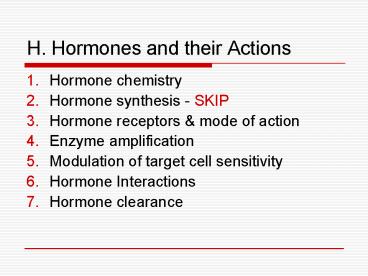H' Hormones and their Actions PowerPoint PPT Presentation
1 / 38
Title: H' Hormones and their Actions
1
H. Hormones and their Actions
- Hormone chemistry
- Hormone synthesis - SKIP
- Hormone receptors mode of action
- Enzyme amplification
- Modulation of target cell sensitivity
- Hormone Interactions
- Hormone clearance
2
1. Hormone Chemistry
- Steroid hormones
- Peptide hormones
- Monoamines
3
Steroid hormones
- Derived from cholesterol
- made by gonads
- estrogens
- progesterone
- testosterone
- made by adrenal cortex
- cortisol
- corticosterone
- aldosterone
- DHEA
4
(No Transcript)
5
6
Peptide hormones
7
(No Transcript)
8
Monoamines
9
(No Transcript)
10
(No Transcript)
11
3. Hormone transport
- Transport proteins
- Purpose to transport hydrophobic hormones in the
blood - Allow them to travel in blood (water solvent)
- Protect them from enzyme degradation in blood
- Hydrophobic hormones
- Steroid hormones
- Thyroid hormone (T3 T4)
- Bound hormone bound to transport protein
- Unbound (free) hormone not bound to transport
protein
12
4. Hormone receptors and mode of action
- general info
- Structure
- Protein/glycoprotein
- Specificity recognize only one hormone
- Saturability finite number of receptors/cell
when all are occupied by hormone molecules, no
increase in binding can occur - Location
- On cell membrane, nucleus, etc. of target cells
- Function
- To bind to and recognize hormone signal
- Binding ? alter target metabolism
13
Steroid hormone receptors
- Hydrodrophobic
- Enter target cells thru plasma membranes
- Enter nucleus and bind to receptors on DNA
- Trigger protein synthesis in target cells
- T4 is converted to T3
- T3 binds to receptors on
- Mitochondria? ? aerobic respiration
- Ribosomes ? ? protein synthesis
- Chromatin ? transcription ? ? mRNA synthesis
- ? ? ATPase ? ? heat (calorigenic effect)
14
Peptides and catecholamines
- Hydrophilic
- Bind to cell surface receptors
- Activate 2nd messenger cascades
- Intracellular events activated by a hormone can
be different in different target cells - ADH (different cascades in kidney vs. smooth
muscle)
15
(No Transcript)
16
(No Transcript)
17
4. Enzyme Amplification
- One molecule of hormone can activate many
molecules of enzyme inside a target cell ? many
more molecules of product.
18
(No Transcript)
19
5. Modulation of target sensitivity
- Up-regulation more receptors, more sensitivity
- Down-regulation fewer receptors, less sensitivity
20
(No Transcript)
21
(No Transcript)
22
(No Transcript)
23
6. Hormone interactions
- Synergistic hormones act together
- Permissive first hormone enhances target
response to second hormone - Antagonistic hormones oppose each other
24
V. Stress Adaptation
- A. Introduction
- B. The Alarm Reaction
- C. The Stage of Resistance
- D. The Stage of Exhaustion
25
Introduction
- Definition any situation which upsets
homeostasis and threatens physical or emotional
well-being - General adaptation syndrome (GAS) (a.k.a., stress
response) - ? EPI, cortisol
- described in stages
26
B. The Alarm Reaction
- NE (sympathetic n.s.) EPI (adrenals)
- Breakdown of stored glycogen ?? blood glucose
- ? aldosterone ? water Na retention
- ? angiotensin ? ? b.p.
27
C. The Stage of Resistance
- Glycogen exhausted
- Requires alternative fuels
- Cortisol plays important role
- ? CRH ? ACTH ? ? cortisol
- Cortisol ? fat, protein, metabolism ? glycerol,
FAs aas ? gluconeogenesis - Protein synthesis inhibited
- Bad for immune system (cant make Abs)
- poor wound healing, etc.
28
D. The Stage of Exhaustion
- Fat reserves important
- When fat depleted ? homeostasis blocked
- Protein breakdown begins ? energy
- progressive wasting
- Adrenals may fail
- No glucocorticoids ? ? gluconeogenesis
- aldosterone ? water retention, hypokalemia ?
n.s. dysfunction, alkalosis (high blood pH), etc.
? potentially fatal
29
VI. Eicosanoids
30
(No Transcript)
31
VII. Endocrine Disorders
- A. Hyposecretion Hypersecretion
- B. Pituitary Disorders
- C. Thyroid Disorders
- D. Parathyroid Disorders
- E. Adrenal Disorders
- F. Diabetes Mellitus
32
Hyposecretion Hypersecretion
- hyposecretion
- diabetes incipidus hyposecretion of ADH
- Hypersecretion
- pheochromocytoma
- Graves disease (toxic goiter)
33
B. Pituitary Disorders
- Hypersecretion
- acromegaly (GH hypersecretion - adult)
- gigantism (GH hypersecretion - child)
- Cushings Disease (ACTH)
- Hyposecretion
- pituitary dwarfism
34
C. Thyroid Disorders
- Hyposecretion
- congenital hypothyroidism
- myxedema
- Iodine deficiency
- endemic goiter
35
D. Parathyroid Disorders
- Hypoparathyroidism
- Hyperparathyroidism
36
E. Adrenal Disorders
- Hypersecretion
- Cushings syndrome (cortisol)
- tumor (ACTH)
- Adrenogenital syndrome (angrogens)
37
F. Diabetes Mellitus
- Symptoms
- POLYURIA (osmotic diuresis)
- POLYPHAGIA
- POLYDIPSIA
- Hyperglycemia
- Glycosuria
- Ketonuria
- ketoacidosis
- Type I insulin-dependent
- Type II non-insulin-dependent
38
VIII. Insight
- Read about the discovery of insulin.

